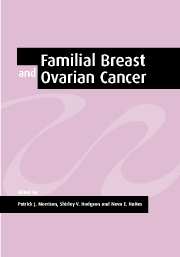Book contents
- Frontmatter
- Contents
- List of contributors
- Foreword by Helena Kennedy
- Preface
- Acknowledgements
- Part 1 Molecular biology and natural history
- Part 2 Screening
- 9 Developing a cancer genetics service: a Welsh model
- 10 Referral criteria for cancer genetics clinics
- 11 Guidelines for the development of cancer genetics services
- 12 Cultural and educational aspects influencing the development of cancer genetics services in different European countries
- 13 Screening, detection and survival patterns of breast and other cancers in high-risk families
- 14 Screening for familial ovarian cancer
- Part 3 Management
- Index
13 - Screening, detection and survival patterns of breast and other cancers in high-risk families
Published online by Cambridge University Press: 24 August 2009
- Frontmatter
- Contents
- List of contributors
- Foreword by Helena Kennedy
- Preface
- Acknowledgements
- Part 1 Molecular biology and natural history
- Part 2 Screening
- 9 Developing a cancer genetics service: a Welsh model
- 10 Referral criteria for cancer genetics clinics
- 11 Guidelines for the development of cancer genetics services
- 12 Cultural and educational aspects influencing the development of cancer genetics services in different European countries
- 13 Screening, detection and survival patterns of breast and other cancers in high-risk families
- 14 Screening for familial ovarian cancer
- Part 3 Management
- Index
Summary
Background
Untreated inherited breast cancer is recognized as a lethal disorder. The first detailed description in modern literature is probably ‘Family Z’, reported by Broca in 1866. If interpreting ‘liver cancer’ as ovarian cancer with spread, Broca described a family with dominantly inherited breast/ovarian cancer syndrome causing early death, and concluded that the cause had to be genetic factors with sex-limited phenotypic expression. He also discussed the putative impact of modifying genetic and environmental factors on the penetrance and expression of the major mutations, which may be discouraging for those who claim to have discovered new insights lately. More than 100 years later, it was agreed that inherited breast cancer was not rare (Iselius et al., 1992). In this chapter, the term ‘inherited’ is used for monogenic inheritance with high penetrance. Recessive or X-linked inherited breast cancer has not been described. The postulated category of inherited breast cancer caused by more frequent mutations with lower penetrance has yet to be defined precisely, and is outside the scope of this chapter. Thus, ‘inherited breast cancer’ denotes dominant inheritance, as indicated by family history or demonstrated mutation. BRCA1, BRCA2, PTEN, TP53 and other genes do, when mutated, cause inherited breast cancer. All mutations proven to cause breast cancer also increase the risk of other cancer(s) (Lynch et al., 1997; Johansson et al., 1999; Chompret et al., 2000).
- Type
- Chapter
- Information
- Familial Breast and Ovarian CancerGenetics, Screening and Management, pp. 204 - 219Publisher: Cambridge University PressPrint publication year: 2002

